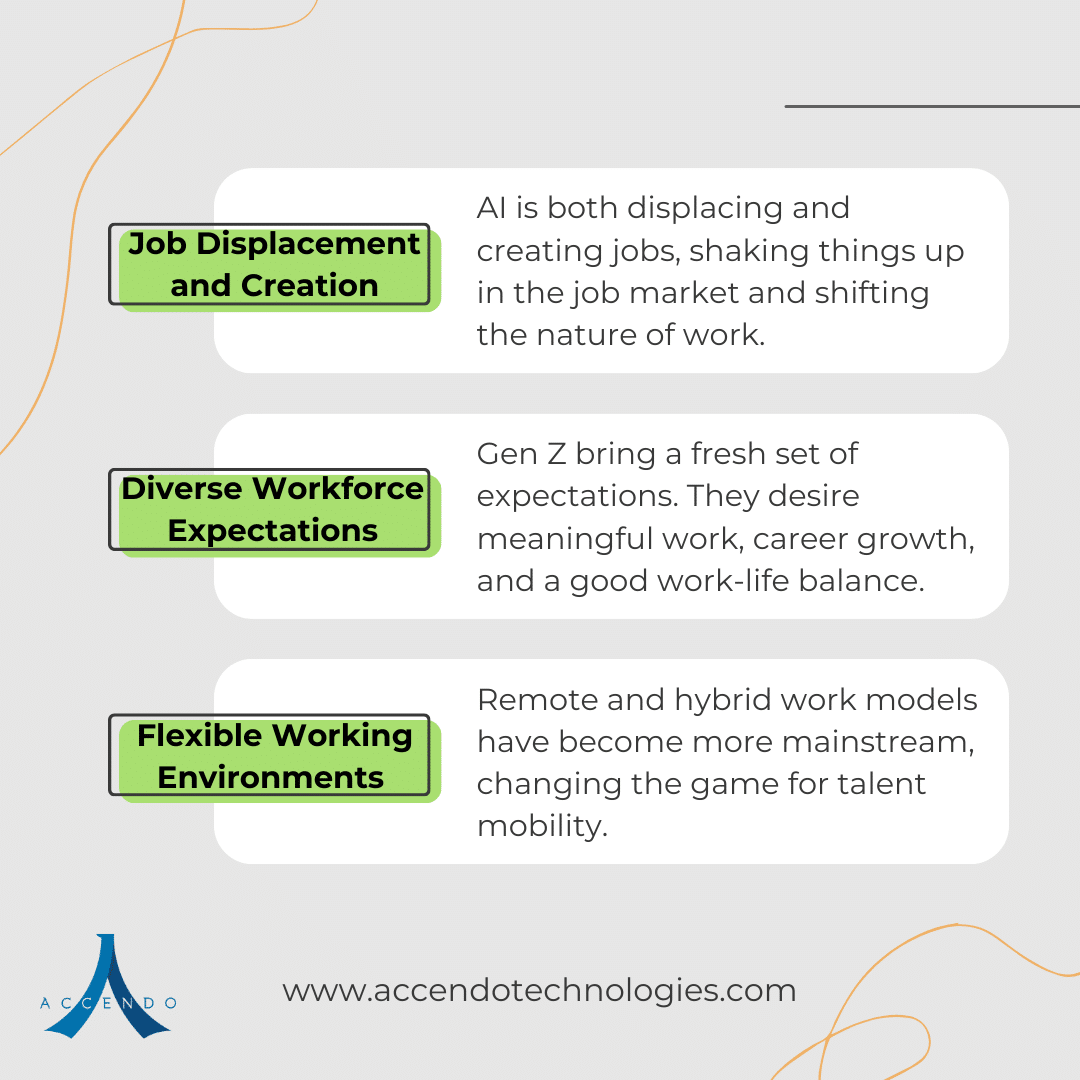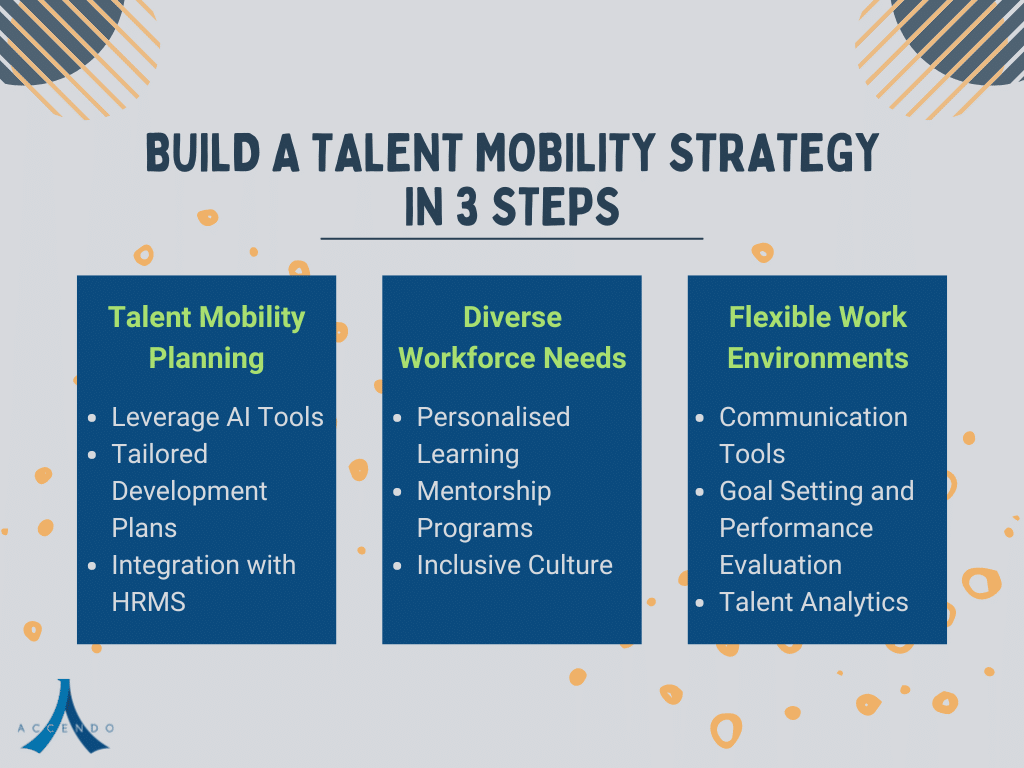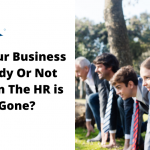The workplace is evolving with Gen Z joining the job market and AI shaking things up. This new wave brings fresh values and expectations, while AI automates tasks and creates new roles, pushing companies to keep up with constant skill updates. To stay ahead, companies need to attract and retain top talent by using AI, creating personalised development plans, integrating HR systems, fostering mentorship, and building inclusive cultures. Our article dives into these changes and offers practical tips for building a strong talent mobility strategy that balances technology with a human touch.
The Current Landscape in Talent Mobility
With Gen Z stepping into the job market and AI advancing rapidly, companies face new challenges and opportunities in talent mobility.
- As older employees retire and Gen Z steps in, the workplace gains a fresh set of values, skills, and expectations. Gen Z brings new energy and ideas, but also different demands.
- AI and digital technology are transforming work, and new job roles are emerging. Companies need to stay on their toes, constantly updating their skills and workforce dynamics to keep up.
- Businesses are more global than ever, and evolving societal norms are pushing for diversity, inclusion, and better work-life balance. Companies need to navigate these waters to build a culture that attracts and retains top talent.
- The COVID-19 pandemic fast-tracked remote work and highlighted the importance of flexibility and digital connections. These changes are here to stay and are reshaping how we work.
- The expectations of tech-savvy Gen Z are for a modern, flexible, and socially conscious workplace. They’re driving the push for inclusive and socially responsible corporate cultures.
- The job market is tough, and economic pressures are pushing companies to adapt. Younger employees are looking for different things in a job such as purpose, balance, and mental health/well-being.
Are Companies Getting It Right?
Only 4% of HR professionals say their internal mobility strategies are fully aligned with broader talent management, showing room for growth. Best practices suggest focusing on internal talent development, promoting a culture of continuous learning, and ensuring top-level support for mobility efforts.
The companies that get it right see big benefits, including:
- Higher employee engagement and retention
- More productivity
- Continuity of knowledge
- Quicker onboarding process
Balancing technology solutions with a human touch is key, as most people don’t want to solely rely on technology for talent mobility programs.
Why Is This Happening?
When it comes to their jobs, Gen Z employees aren’t planning on sticking around for long. A whopping 83% consider themselves “job hoppers,” according to a survey by ResumeLab. Surprisingly, many of these job hoppers are employees with master’s degrees. But there’re other reasons too.

AI-Induced Job Displacement and Creation
AI is both displacing and creating jobs, shaking things up in the job market and shifting the nature of work. While AI and automation might replace certain roles, especially those involving repetitive tasks, but they’re also creating new opportunities that require advanced technical skills.
The challenge lies in reskilling and upskilling employees to step into these new roles. It’s about being proactive, identifying emerging skills, and investing in employee development.
Diverse Workforce Expectations
Gen Z employees bring a fresh set of expectations. They desire meaningful work, career growth, and a good work-life balance. Managing a multi-generational workforce adds complexity, with different age groups having their own preferences and work styles.
As a result, companies need to tailor their talent mobility strategies to meet these diverse needs, creating an inclusive and supportive environment for everyone.
Flexible Working Environments
Remote and hybrid work models have become more mainstream, changing the game for talent mobility. These models can help companies attract and retain a more diverse workforce while offering employees more flexibility.
Ensuring equitable career progression for remote employees can be tough since they might not be as visible as their in-office colleagues. To make it work, companies need clear communication and a focus on outcomes rather than just physical presence when evaluating performance.
Building a Solid Talent Mobility Strategy for the Modern Workplace
Navigating the complexities of the modern workplace requires a robust talent mobility strategy. Here’s how you can do it right:

Strategic Talent Mobility Planning
Leverage AI Tools
Using AI-driven analytics to identify skill gaps and match employees with new opportunities is a paradigm shift. Accendo Technologies uses AI in TalentPulse, their talent intelligence platform, to tailor development plans through employees’ skills gaps analysis. Reach out to our sales team for more information.
Tailored Development Plans
Create personalised development plans that align with your employees’ career aspirations. This enhances engagement and promotes internal mobility. Companies like AT&T have successfully implemented this by offering tailored reskilling programs that align with future technology trends, resulting in a more agile and motivated workforce.
Integration with HRMS
Utilise platforms that seamlessly integrate with your core HR Management Systems (HRMS) to streamline talent acquisition and management. This makes managing talent data and processes a breeze. Workday is a great example – they provide an integrated system that handles everything from recruitment to development, boosting productivity.
Catering to Diverse Workforce Needs
Personalised Learning
Develop customised learning plans and utilise continuous learning tools with cognitive and psychometric assessments to align with your employees’ individual strengths and your organisational goals. Deloitte’s implementation of personalised learning platforms has led to higher employee engagement and better alignment of skills with their business needs.
Mentorship Programs
Mentorship and reverse mentorship initiatives can bridge generational gaps and encourage knowledge transfer. General Electric’s (GE) mentorship programs are a hit – promoting knowledge sharing while enhancing leadership development across the board.
Inclusive Culture
Creating an inclusive environment that values diversity is key. It not only makes employees feel valued but also ramps up engagement and satisfaction. Salesforce is a prime example – they’re renowned for their inclusive culture, which has resulted in a highly engaged and loyal workforce, leading to better business results.
Managing Flexible Work Environments
Communication Tools
Effective communication and collaboration tools are essential, especially for remote and hybrid teams. These tools ensure all employees have equal access to resources within the company. Tools like Slack and Microsoft Teams facilitate seamless communication and collaboration, which are essential elements for managing flexible work environments.
Goal Setting and Performance Evaluation
Keep performance evaluations and career progression criteria transparent to maintain fairness. Google’s use of OKRs (Objectives and Key Results) provides a clear framework for performance assessment, while Accendo’s use of the framework helps the organisation and the teams define and track objectives and measure their progress towards achieving them.
Talent Analytics
Utilise real-time talent analytics to keep an eye on employee performance and provide timely support for career development. Companies like Cisco use advanced analytics to track employee performance and development needs, enabling prompt interventions and career support.
What Does This Mean for You?
The urgency is clear: if your talent mobility program isn’t up to par, you’re at risk of losing your Gen Z talent to more adaptive competitors. This generation is driving the need for modern, flexible, and socially conscious workplaces. The challenge lies in balancing technology with a human touch, but the rewards – higher engagement, retention, and a competitive edge – make it essential. Ready to transform your mobility program? Start today by integrating these strategies and stay ahead of the curve.
Page Contents






